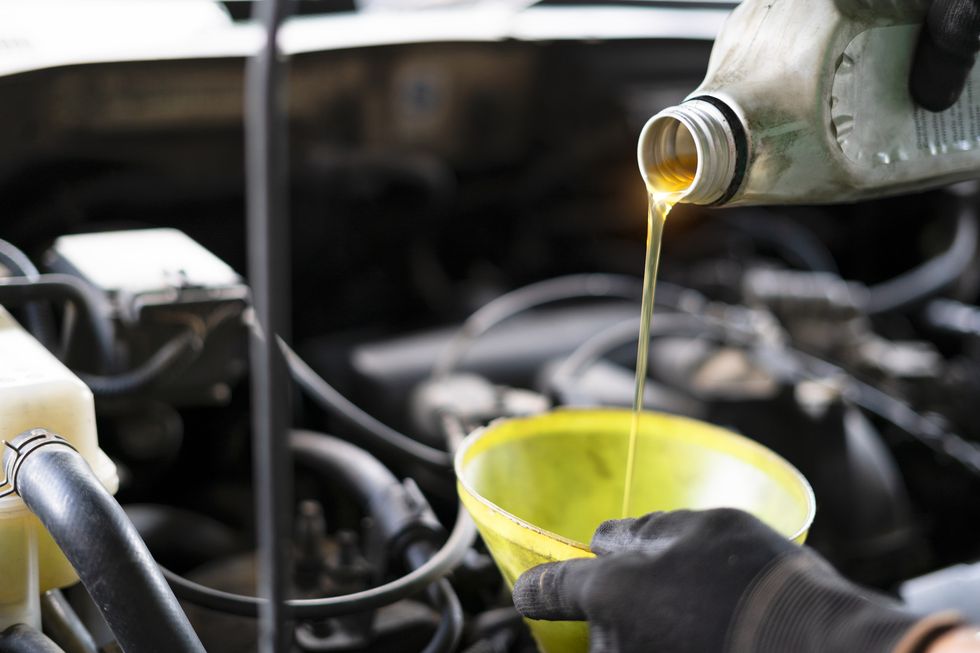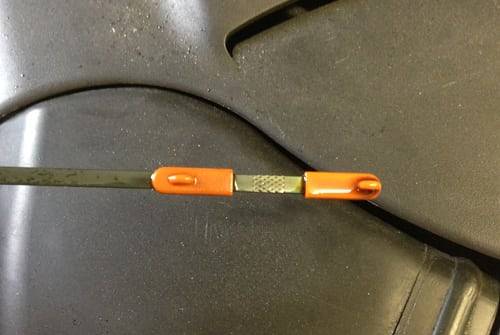It is recommended to refill engine oil every 5,000 to 7,500 miles depending on the type of vehicle and driving conditions. Regular oil changes are important to maintain the health and longevity of your engine.
Neglecting to refill engine oil can lead to engine damage and costly repairs. In addition, checking the oil level regularly and topping it off when necessary can help prevent low oil levels and potential engine damage. By following a regular oil change schedule and checking oil levels, you can keep your engine running smoothly for years to come.

Credit: www.popularmechanics.com
The Importance Of Engine Oil
Engine oil is crucial for the smooth operation of your vehicle. It lubricates the moving parts of the engine, reducing friction and preventing wear and tear. Low engine oil can lead to overheating and damage to the engine. Regular checks are important to ensure that the oil level is maintained within the recommended range. Signs of low engine oil include engine knocking, excessive exhaust smoke, and the oil pressure warning light coming on. It is recommended to check the oil level at least every 1000 miles and top up if necessary to keep the engine running smoothly.
Refilling Vs. Changing Oil
Regularly checking and topping up your engine oil is essential to maintain proper lubrication and prevent engine damage. The frequency of refilling your oil depends on your vehicle’s age, mileage, and driving habits. Newer cars may require less frequent oil additions, while older vehicles or those with high mileage may need more frequent top-ups. In general, it’s recommended to check the oil level at least once a month and add oil as needed to keep it between the minimum and maximum marks on the dipstick. On the other hand, oil changes are typically performed every 5,000 to 7,500 miles, but this can vary based on the manufacturer’s recommendations and the type of driving you do. Following the manufacturer’s guidelines for both refilling and changing oil is crucial for maintaining the health of your engine.
Ideal Frequency For Oil Refills
When it comes to how often you should refill engine oil, there are general guidelines to follow. However, it’s important to note that the frequency can vary depending on several factors.
General Guidelines:
- Most car manufacturers recommend changing engine oil every 5,000 to 7,500 miles or every six months, whichever comes first.
- If you frequently drive in harsh conditions such as extreme temperatures or dusty environments, you may need to change the oil more often.
- High-performance vehicles may require more frequent oil changes due to their demanding engine requirements.
- Regularly checking the oil level and quality can help determine if a refill is needed. If the oil level falls below the minimum mark, it’s advisable to top up.
Factors That Influence Frequency:
- Driving habits: Frequent stop-and-go driving or short trips can lead to faster oil degradation.
- Vehicle age and mileage: Older cars or those with high mileage may require more frequent oil refills.
- Oil type: Synthetic oils tend to last longer and may require less frequent refills compared to conventional oils.
Remember, following the manufacturer’s recommendations and regularly checking the oil level will help ensure the engine stays properly lubricated, leading to better performance and longevity.

Credit: www.theaa.com
Checking Engine Oil Levels
To maintain optimal engine performance, it’s important to check and refill the engine oil regularly, ideally every 3,000 to 5,000 miles. Keeping an eye on the oil level and topping up as needed helps to ensure smooth running and longevity of the engine.
Regular oil checks also allow for early detection of any potential issues, preventing costly damage in the long run.
Steps To Check Oil Level
When it comes to checking the oil level in your engine, the first step is to locate the oil dipstick. The dipstick is usually a long, thin metal rod with a handle. It is typically found near the front of the engine. Once you’ve located the dipstick, follow these steps:
- Make sure the engine is turned off and has cooled down.
- Remove the dipstick from its housing.
- Wipe the dipstick clean with a cloth or paper towel.
- Insert the dipstick back into its housing completely.
- Remove the dipstick again and observe the oil level.
- If the oil level is below the minimum mark, you should add more oil.
- If the oil level is between the minimum and maximum marks, it is within the appropriate range.
- If the oil level is above the maximum mark, it may indicate overfilling and should be addressed.
Remember to refer to your vehicle’s owner’s manual for specific instructions and recommended oil change intervals. Regularly checking and maintaining the proper oil level in your engine is essential for optimal performance and longevity.
Consequences Of Neglecting Oil Levels
Regularly checking and refilling engine oil is crucial for maintaining a healthy engine. Neglecting oil levels can lead to severe consequences, including engine damage and reduced fuel efficiency. When oil levels are low, the engine has to work harder, resulting in increased friction and heat, which can cause damage to engine parts. This damage can be costly to repair and can even result in the need for a full engine replacement. Reduced fuel efficiency is another consequence of neglecting oil levels. When the engine is not properly lubricated, it has to work harder to perform the same tasks, resulting in increased fuel consumption. Therefore, it is essential to check and refill engine oil regularly to avoid these consequences.

Credit: www.cars.com
How To Choose The Right Engine Oil
Refilling engine oil should be done as needed, based on the oil level. Regularly check the oil level using the dipstick and top it up if it falls below the recommended mark. The frequency of refilling will depend on the engine’s oil consumption rate and the manufacturer’s guidelines.
| Types of Engine Oil | Reading Oil Labels |
|---|---|
| There are three main types of engine oil: mineral, synthetic, and semi-synthetic. Mineral oil is the most basic and cheapest option, while synthetic oil is more expensive but offers better performance and lasts longer. Semi-synthetic oil is a blend of mineral and synthetic oils, offering a balance between cost and performance. | When reading oil labels, it’s important to pay attention to the viscosity grade, which indicates how easily the oil flows at different temperatures. The Society of Automotive Engineers (SAE) has developed a grading system based on a number followed by a letter ‘W’ (for winter) to indicate how the oil performs in cold weather. For example, 5W-30 oil is suitable for use in colder climates, while 10W-40 oil is better suited for warmer temperatures. Additionally, look for oil that meets the American Petroleum Institute (API) standards for your car’s engine. |
When it comes to choosing the right engine oil, it’s important to consider the type of oil and its viscosity grade. Different types of oil offer different performance and longevity, so it’s important to choose the one that best suits your needs and budget. When reading oil labels, make sure to pay attention to the viscosity grade and API standards to ensure that the oil is suitable for your car’s engine. By choosing the right engine oil and regularly refilling it as needed, you can help keep your car running smoothly and avoid costly repairs.
Diy: Refilling Your Engine Oil
Refilling your engine oil is an essential part of car maintenance. But how often should you do it? It is recommended to check your oil levels regularly and refill as needed, especially if the level is below the minimum mark.
Keeping your engine properly lubricated will help extend its lifespan and ensure optimal performance.
Required Tools
| Tool | Description |
|---|---|
| Oil filter wrench | Used to remove the old oil filter |
| Oil drain pan | Collects the old oil during the draining process |
| Funnel | Helps to pour the new oil into the engine without spilling |
| Rag or paper towel | Used to clean any spills or drips |
Refilling engine oil is an important maintenance task to keep your car running smoothly. Here is a step-by-step guide to help you through the process:
- Start by parking your car on a level surface and turning off the engine.
- Locate the oil filter and oil drain plug underneath the car.
- Place the oil drain pan beneath the drain plug and use the wrench to loosen and remove the plug.
- Allow the old oil to fully drain into the pan.
- Once drained, replace the drain plug and tighten it securely.
- Using the funnel, pour the new oil into the engine, making sure to check the manufacturer’s recommended oil type and quantity.
- After refilling, check the oil level using the dipstick and add more if necessary.
- Dispose of the old oil properly at a recycling center.
By following these steps and refilling your engine oil at regular intervals, you can ensure the longevity and performance of your vehicle.
Professional Help Vs. Diy
When it comes to refilling engine oil, you may wonder whether to seek professional help or do it yourself (DIY). Knowing when to seek professional help is crucial for ensuring the proper maintenance of your engine. If you lack the necessary knowledge and experience, it is best to leave it to the professionals. They have the expertise to identify any underlying issues and provide the appropriate solutions. However, if you prefer a hands-on approach and have some knowledge about engine oil, DIY can be beneficial. It allows you to save money and have a better understanding of your vehicle’s needs. Just make sure to follow the manufacturer’s guidelines and use the correct oil grade. Regularly checking your oil level and condition is essential to ensure optimal engine performance.
Frequently Asked Questions
How Often Should You Have To Top Up Engine Oil?
You should top up engine oil if the level is below the minimum mark. Generally, a well-maintained car engine should not require oil top-up between service intervals.
How Often Should Car Oil Be Refilled?
It is recommended to check and top off your car’s engine oil at least once a month. However, the frequency of refilling car oil depends on factors such as the type of vehicle, driving conditions, and oil type. It is best to refer to the car’s manual or consult with a mechanic to determine the appropriate oil change and refill schedule for your car.
How Long Should Engine Oil Last?
Engine oil should be changed at least once a year or every 7,500 miles, whichever comes first. However, it is important to check the manufacturer’s recommendations for your specific vehicle as some may require more frequent oil changes. Regularly checking the oil level and topping it up when necessary can also help extend the life of the engine oil.
Is It Normal To Refill Engine Oil?
Yes, it is normal to refill engine oil if the level is below the minimum mark.
Conclusion
Maintaining the right oil level is crucial for the health of your engine. Regularly checking your oil level and topping up as needed can prevent damage and ensure optimal performance. By following the manufacturer’s recommendations and keeping an eye on your oil level, you can prolong the life of your engine and avoid costly repairs.
